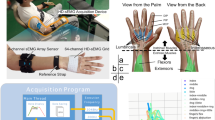Abstract
For describing the state of the wrist, either the force or movement of wrist can be measured as the training target in the simultaneous electromyography control. However, the relationship between the force and movement is so complex that only the force or movement is not precise enough to describe its actual situations. In this paper, we propose a novel platform that can acquire three degrees of freedom (DOF) wrist motion/force synchronously with multi-channel electromyography signals in a hemi-constraint way. The self-made wrist force-movement mapping device establishes a stable relationship between the wrist movement and force. Meanwhile, the elicited wrist movement can be directly fed back to the subjects via laser cursor. The information of the cursor can directly reflect the 3-DOF movement of the wrist without any decoupling algorithms. Through this platform, the support vector regression model learned from the training data can well predict the arbitrary combinations of 3-DOF wrist movements. The cross-validation result indicates that the regression accuracy of free 3-DOF movements can reach a similar performance to that of 2-DOF regular movements (in terms of R2, regular movement vs. free movement, p > 0.1).

The hemi-constrained platform used for detecting 3-DOF wrist movements.










Similar content being viewed by others
References
Atzori M, Müller H (2015) Control capabilities of myoelectric robotic prostheses by hand amputees: a scientific research and market overview. Front Syst Neurosci 9. https://doi.org/10.3389/fnsys.2015.00162
Erik S, Kevin E (2011) Electromyogram pattern recognition for control of powered upper-limb prostheses: state of the art and challenges for clinical use. J Rehabil Res Dev 48:643–659
Phinyomark A, Quaine F, Charbonnier S, Serviere C, Tarpin-Bernard F, Laurillau Y (2013) EMG feature evaluation for improving myoelectric pattern recognition robustness. Expert Syst Appl 40:4832–4840
Oskoei MA, Hu H (2008) Support vector machine-based classification scheme for myoelectric control applied to upper limb. IEEE Trans Biomed Eng 55:1956–1965
Huang Y, Englehart KB, Hudgins B, Chan AD (2005) A Gaussian mixture model based classification scheme for myoelectric control of powered upper limb prostheses. IEEE Trans Biomed Eng 52:1801–1811. https://doi.org/10.1109/TBME.2005.856295
Scheme EJ, Englehart KB, Hudgins BS (2011) Selective classification for improved robustness of myoelectric control under nonideal conditions. IEEE Trans Biomed Eng 58:1698–1705
Castellini C, Artemiadis P, Wininger M, Ajoudani A, Alimusaj M, Bicchi A, Caputo B, Craelius W, Dosen S, Englehart K (2014) Proceedings of the first workshop on peripheral machine interfaces: going beyond traditional surface electromyography. Front Neurorobotics 8:22. https://doi.org/10.3389/fnbot.2014.00022
Kamavuako EN, Scheme EJ, Englehart KB (2013) Wrist torque estimation during simultaneous and continuously changing movements: surface vs. untargeted intramuscular. EMG. J Neurophysiol 109:2658–2665
Ameri A, Kamavuako EN, Scheme EJ, Englehart KB, Parker PA (2014) Support vector regression for improved real-time, simultaneous myoelectric control. IEEE Trans Neural Syst Rehabil Eng 22:1198–1209. https://doi.org/10.1109/TNSRE.2014.2323576
Ameri A, Kamavuako EN, Scheme EJ, Englehart KB, Parker PA (2014) Real-time, simultaneous myoelectric control using visual target-based training paradigm. Biomed Signal Process 13:8–14
Hahne J, Rehbaum H, Biessmann F, Meinecke FC, Müller K-R, Jiang N, Farina D, Parra LC (2012) Simultaneous and proportional control of 2D wrist movements with myoelectric signals. In: Machine Learning for Signal Processing (MLSP), 2012 I.E. International Workshop on, 2012. IEEE, pp 1–6. https://doi.org/10.1109/MLSP.2012.6349712
Jiang N, Vest-Nielsen JL, Muceli S, Farina D (2012) EMG-based simultaneous and proportional estimation of wrist/hand kinematics in uni-lateral trans-radial amputees. J Neuroeng Rehabil 9:1–11
Ngeo JG, Tamei T, Shibata T (2014) Continuous and simultaneous estimation of finger kinematics using inputs from an EMG-to-muscle activation model. J Neuroeng Rehabil 11:1–14
Ning J, Englehart KB, Parker PA (2008) Extracting simultaneous and proportional neural control information for multiple-DOF prostheses from the surface electromyographic signal. IEEE Trans Biomed Eng 56:1070–1080
Ameri A, Scheme EJ, Kamavuako EN, Englehart KB (2014) Real-time, simultaneous myoelectric control using force and position-based training paradigms. IEEE Trans Biomed Eng 61:279–287
Nielsen JL, Holmgaard S, Jiang N, Englehart K, Farina D, Parker P (2009) Enhanced EMG signal processing for simultaneous and proportional myoelectric control. In: Engineering in Medicine and Biology Society, 2009. EMBC 2009. Annual International Conference of the IEEE, 2009. IEEE, pp 4335–4338. https://doi.org/10.1109/IEMBS.2009.5332745
Boyd HC (2009) Measurement of functional wrist motion. PhD Dissertation, University of Bath
Deans SR (1981) Hough transform from the Radon transform. IEEE Trans Pattern Anal Mach Intell PAMI-3:185–188
Yang W, Yang D, Liu Y, Liu H (2015) Three-dimensional simultaneous EMG control based on multi-layer support vector regression with interactive structure. In: International conference on intelligent robotics and applications, 2015. Springer, pp 282–293. https://doi.org/10.1007/978-3-319-22879-2_26
Chang C-C, Lin C-J (2011) LIBSVM: a library for support vector machines. ACM Trans Intell Syst Technol 2:27–27. https://doi.org/10.1145/1961189.1961199
Funding
This work is partially supported by the National Natural Science Foundation of China (Nos. 51675123, 61603112), the Foundation for Innovative Research Groups of the National Natural Science Foundation of China (Grant No.51521003), and the Self-Planned Task of State Key Laboratory of Robotics and System (No. SKLRS201603B).
Author information
Authors and Affiliations
Corresponding author
Electronic supplementary material
ESM 1
(MP4 14,370 kb)
Rights and permissions
About this article
Cite this article
Yang, W., Yang, D., Liu, Y. et al. A 3-DOF hemi-constrained wrist motion/force detection device for deploying simultaneous myoelectric control. Med Biol Eng Comput 56, 1669–1681 (2018). https://doi.org/10.1007/s11517-018-1807-2
Received:
Accepted:
Published:
Issue Date:
DOI: https://doi.org/10.1007/s11517-018-1807-2




